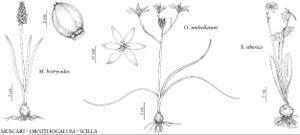Muscari botryoides
Gard. Dict. ed. 8, Muscari no. 1. 1768.
Plants to 20 (–30) cm. Bulbs ovoid, 1.5–2.5 × 1–2 cm, offsets absent, tunics translucent to pale-brown. Leaves 2–4 (–5); blade prominently ribbed, linear-spatulate, 15–35 (–40) cm × 3–8 (–12) mm, apex abruptly contracted. Scape 20–35 (–40) cm, usually slightly exceeding leaves. Racemes 12–20-flowered. Flowers: perianth-tube sky blue, globose to ovoid, 2–4 × 2–3 mm, teeth white; fertile and sterile flowers ± equal (sterile may slightly smaller and paler); pedicel spreading, 1–3 (–5) mm. Capsules 4–6 × 4–6 mm. 2n = 18, 36.
Phenology: Flowering early–mid spring.
Habitat: Roadsides, fields, woods, abandoned gardens
Elevation: 0–1500 m
Distribution
Introduced; B.C., Nfld. and Labr. (Nfld.), N.S., Ont., Ala., Ark., Calif., Conn., Del., D.C., Ill., Ind., Kans., Ky., Md., Mass., Mich., Minn., Miss., Mo., N.H., N.J., N.Y., Ohio, Okla., Oreg., Pa., Tenn., Tex., Utah, Vt., Va., Wash., W.Va., c, se Europe, expected elsewhere
Discussion
Muscari botryoides is the commonest and most cold-hardy of the Muscari species in the flora.
Selected References
None.
Lower Taxa
"elongating" is not a number."thicker" is not a number.
